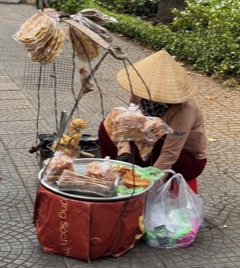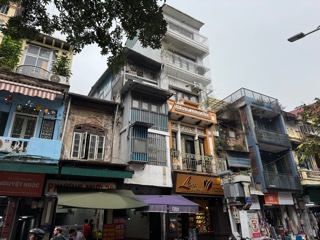Vietnam City Life

Casamara
John & Susan Simpson
Sun 30 Mar 2025 12:43
| In the first six months of 2024 more than 2,248 Vietnamese nationals boarded small boats in France to try to reach the UK across the English Channel. More Vietnamese tried to make the crossing than from any country with known human rights issues. We’d just arrived in Vietnam when I first read those statistics and it was puzzling to look around and wonder why people would flee this country when it seems to be booming. Vietnam’s growth has been so rapid that its economy is expected to exceed that of Singapore by the end of this decade. We can only wonder at the circumstances that make people pay tens of thousands of pounds to the traffickers rather than investing that cash in themselves in their home country. We started our Vietnam cities tour in Hanoi, where we were joined by Letitia and Derek from SV Mary Doll, and travelled with them to Hoi An then on to Ho Chi Minh City (Saigon). Hanoi and HCMC are bustling capital cities (North and South Vietnam) which offer an eclectic mix of upmarket shops and restaurants, markets and street traders. It’s not unusual to see a lady sitting on her haunches cooking home made waffles over hot coals in an iron bucket, whilst behind her is a shiny new shopping mall stuffed with Chanel, Dior, Burberry etc. Street food is a big thing across Vietnam, with the pavements turning into pop up cafes, restaurants or even cocktail bars just by setting out plastic chairs or deckchairs on the pavement and serving from a portable kitchen or bar. Hoi An, located roughly half way up the country, is by contrast a popular tourist destination, being a historic trading port dating back to the 15th century and now filled with bespoke dressmaking and tailoring shops, lantern makers, coffee shops and restaurants.  Our journey from North to South Vietnam: Hanoi - Hoi An (Da Nang) - Ho Chi Minh City  Lanterns in Hoi An  Waffle seller in HCMC. Everything she needs is carried on her shoulder and they are VERY heavy  High-rise Ho Chi Minh City You know you’re in for something a bit different when hotels include a paragraph in their welcome notes on how to cross the road. In Vietnam pedestrians are at the bottom of the pecking order when it comes to getting about, and motor scooters are king. In Ho Chi Minh City there are 8.5 million registered scooters for a population of 9.5 million people. The flow of scooters is incessant, sometimes with the direction of traffic and sometimes against it. They don’t stop at junctions unless they absolutely have to and the drivers don’t look to see if anything is coming when they pull out. A green man on a pedestrian crossing just means they might have to weave around people as they drive straight on by. Basically the rules for crossing the road are: look before you step out, don’t run, don’t stop and never turn back once you’re crossing. It took us a while to get used to it, but the traffic does just glide around you if you hold your nerve and walk confidently across. Pavements can’t be relied upon for safe walking either. They’re the perfect place to park scooters, or even cars. That’s when they’re not being used for the pop up eating establishments. Many times we walked in the gutter because there simply was no room on the pavement. It must be a nightmare if you rely on a wheelchair.  Pavement parking in Hanoi - note also the scooter using the pedestrian crossing in the background  Scooters can carry whole families, mounds of boxes, step ladders, double mattresses, you name it… Characteristic of Vietnam are the tall, narrow, multi-storey houses, known as tube houses. These emerged in the 19th century when city space was at a premium and properties were taxed by the width of their frontage, typically 3 to 4 metres wide. They’re common across Vietnam, even in rural areas where you can come across one narrow, four or five-storey house built in the middle of a field.  Tube houses Sitting in a restaurant in Hanoi one evening we noticed that all of the tables around us were filled with young women who were constantly arranging and rearranging their hair, whipping pink hair rollers in and out of their fringes, posing and pouting for hundreds of selfies seemingly oblivious to the world around them. Chatting with our waitress, we asked what was going on. ’This is a famous wall’, she said. ’The girls are taking selfies of themselves in front of the wall to share on Tik Tok. It’s a nuisance for the bar owners because they buy one drink and then sit for the whole evening taking photos of themselves’. Once we’d noticed the phenomenon, we spotted it happening in all sorts of different places, sometimes also in traditional dress and with a photographer to take professional shots. Vietnam ranks fifth in the world for number of Tik Tok users.  Photo shoot in a Hoi An street It wouldn’t be right to end this piece on Vietnam without a mention of the Vietnam War (1955-1975). In Hanoi we walked through a densely populated residential area to find a US B52 Bomber which had been shot down and landed in a lake in the heart of the residential area. The twisted wreckage has been left where it landed as a permanent reminder of the war. We also visited the War Remnants Museum in HCMC to see the incredibly moving exhibition of photographs taken by photojournalists during the war, including the iconic photo of the young Vietnamese girl running away from her village severely burned by napalm. The plane wreckage amongst the housing and the photos in the museum showed clearly the devastating impact on civilians of the Vietnam War and it's remarkable how far Vietnam has come in only 50 years.  B52 Bomber wreckage We said a sad farewell to Letitia and Derek in HCMC. We’ve sailed in company with them since we left St Lucia in February 2023 and we’re going our separate ways now: Casamara will be sailing across the Indian Ocean and Mary Doll is to be loaded onto a ship bound for Turkey. But as the old song goes, 'we’ll meet again, don’t know where, don’t know when'. We left HCMC to go back for a flying visit to check on Casamara in Malaysia before continuing our land travels with the very first visit for both of us to Seoul in South Korea. |